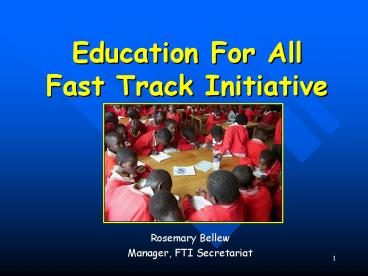Education For All Fast Track Initiative - PowerPoint PPT Presentation
1 / 27
Title:
Education For All Fast Track Initiative
Description:
Mauritania. Bolivia. Honduras. Burkina Faso. 17 million. children out of school. 50 million children ... Mauritania. Guinea. Endorsed in 2003. The Gambia ... – PowerPoint PPT presentation
Number of Views:84
Avg rating:3.0/5.0
Title: Education For All Fast Track Initiative
1
Education For AllFast Track Initiative
- Rosemary Bellew
- Manager, FTI Secretariat
2
- Origin of FTI
- What is FTI objectives and components
- Implementation progress
- Challenges
- Discussion questions
3
Origin
- Jomtien World Declaration on Education for
All - UPE by 2000, over100 million out of school
- World Education Forum April 2000, Dakar
- Increase aid and predictability
- Sector-wide approaches, more effective donor
coordination - Regular monitoring at country and international
level - MDGs adopted September 2000
- Monterrey Consensus, March 2002 International
Finance and Development Conference, state heads - Mobilizing and increasing effective use of aid
(and trade) to reach MDGs - Countries with sound policies and programs
- Good governance, increased accountability
- Rome Declaration on Harmonization February 2003
to improve aid effectiveness
4
The FTI is
- Global Partnership of education donors (25
bilateral and multilateral donors), endorsed by
World Bank/IMF Development Committee and G-8 - It aims to
- Support countries to achieve the MDG for
completion of primary education for all, through
increased aid by - Putting into practice the principles of the
Monterrey Consensus and Rome Declaration
5
Why FTI? Dramatically faster progress is needed
in some regions Trends in PCR by Region
6
Projected trends in PCR for some FTI countries
(projections use a line of best fit between data
points)
7
many countries are off track
Source Linear projections based on 1990 to 2002
data from the WDI database July 2004, includes
low and middle income countries
8
Many countries are off track
9
Aid not as effective as it could be
- Multiple donor requirements increase transaction
costs - Project approaches do not address systemic issues
and policies sufficiently - Donor cycles do not always fit with Government
planning and budgeting cycles - Funding does not always match Government
priorities
10
The FTI compact and eligibility
- Donors commit to increase aid and its
predictability to scale up programs to achieve
the MDG for primary education, based on country
performance - Eligibility
- All low-income countries with
- PRSP or equivalent
- Sound education policies and sector program,
endorsed by country donors - Commitment to monitor key indicators (Indicative
Framework)
11
EFA Indicative Framework
- Benchmarks drawn from analysis of successful EFA
countries. Crucial for the long-term
sustainability of MDG progress - Domestic financing effort
- Actions to improve service delivery
- 1) government spending on education 20 of
budget - 2) spending on primary education 50 of
education budget - 3) teacher salary about 3.5 times GDP per
capita - 4) pupil-teacher ratio about 401
- 5) non-teacher salary spending 33 of
recurrent spending - average repetition rate 10 or lower
- annual hours of instruction 850 or more
- unit construction costs - 10,000 or lower
12
Main Objective 1
- Increase financing and predictabilty
- Regular channels
- Donor Orphans -- Catalytic Fund
- Fund for Preparation of Education Sector Plans
13
Main Objective 2
- Channel aid more efficiently and effectively
- Donor collaboration and harmonization
- More flexible financing
- Recurrent costs
14
EFA-FTI Catalytic Fund (CF)
- Two/three year transitional financing
- Low income countries with
- Insufficient financing (due to insufficient
donors) that - Meet the EFA-FTI eligibility criteria
15
Contributors to the CF2004-2007
Source Report of Committee decisions of the
first meeting of the Strategy Committee for the
Catalytic Fund Oslo, November 22, 2003 and
subsequent Administrative Agreements
16
Country Allocations (US million)
17
(No Transcript)
18
FTI first 23 countries
- Two transparent criteria
- For invitation Poverty Reduction Strategy
- For endorsement for funding Primary Education
Sector Plan agreed with donors supporting
education in the country - 23 Countries invited 18 in FTI proper 5 in
analytical track
17 million children out of school
50 million children out of school
19
FTI Progress to Date
- Endorsed 11/02
- Nicaragua
- Honduras
- Guyana
- Burkina Faso
- Niger
- Mauritania
- Guinea
- Endorsed in 2003
- The Gambia
- Mozambique
- Yemen
- Vietnam
- Endorsed in 2004
- Ghana
20
Results
- Increased focus on completion
- Improved the linkages between central and field
levels in donor agencies - Greater partnership
- Increased attention to sector programs and
non-project financing mechanisms - Increased aid
21
Trends in aid Bilateral ODA World Bank
commitments
22
Trends in Bilateral AID in selected FTI countries
23
Trends in Bilateral Aid increase
24
Other On Going Work
- Harmonization Working Group
- Country level donor harmonization monitoring
indicators - Finance Working Group
- Accounting for Budget Support
- Estimating the Global Financing Gap
- Impact of finance modalities (GBS and SBS) on
education outcomes - Communications Working Group
- Messaging
- Fund for Preparation of Education Sector Plans
25
Challenges
- Country level
- Predictable aid commitments
- Monitoring the compact gaps, financial flows
and country progress - Expansion
26
Discussion
- What have been your experiences with FTI?
- How can FTI support country level processes ?
- What value added can FTI bring?
27
Thank You for Your Attention
- www1.worldbank.org/education/efafti/
- Rosemary Bellew 34836































